


ROBBIE BURNS 1759 -
xxxxxThe Scottish poet Robbie Burns, who started life as a humble farmer, gained immediate fame in 1786 with the publication of his Poems, Chiefly in the Scottish Dialect. Written about the lives of ordinary folk in his native Ayrshire, they tell of their loves, joys and sorrows, and capture the very spirit of rural Scotland. A man of the people and fiercely independent, some of his works are used to satirise the short-
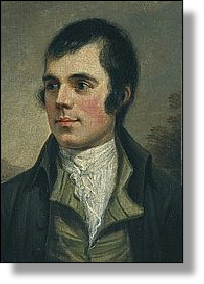 xxxxxRobert Burns was the “ploughman poet” who wrote about the humble farming folk of his native Ayrshire. Couched for the most part in Lallans, the dialect of Lowland Scotland, his poems and songs tell of their daily lives, capturing, by his descriptive powers and his deep love of humanity, the very spirit of his rural homeland. He it was who gave the common man a proud and worthy place in society. Regarded today as one of Scotland’s outstanding literary figures, his genius as a poet and lyricist has made his works known and loved -
xxxxxRobert Burns was the “ploughman poet” who wrote about the humble farming folk of his native Ayrshire. Couched for the most part in Lallans, the dialect of Lowland Scotland, his poems and songs tell of their daily lives, capturing, by his descriptive powers and his deep love of humanity, the very spirit of his rural homeland. He it was who gave the common man a proud and worthy place in society. Regarded today as one of Scotland’s outstanding literary figures, his genius as a poet and lyricist has made his works known and loved -
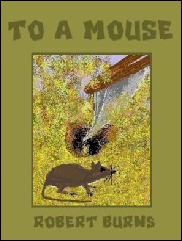 xxxxxHis poems, in portraying a vivid description of pastoral life in times of joy and sorrow, range from the tender to the earthy, and embrace a variety of emotions, from the romantic and humorous to the scornful and satirical. Believing firmly in individual freedom and social justice, he attacked society’s shortcomings in a number of works, using his sharpest wit to condemn unkindness, sham and religious hypocrisy. Best known amongst his poems are his Highland Mary, The Twa Dogs, Hallowe’en, To a Mouse, To a Mountain Daisy, The Holy Fair, The Cotter's Saturday Night, and The Jolly Beggars, a detailed, spirited drama about a group of outcasts. His Holy Willie’s Prayer, laying open to ridicule the self-
xxxxxHis poems, in portraying a vivid description of pastoral life in times of joy and sorrow, range from the tender to the earthy, and embrace a variety of emotions, from the romantic and humorous to the scornful and satirical. Believing firmly in individual freedom and social justice, he attacked society’s shortcomings in a number of works, using his sharpest wit to condemn unkindness, sham and religious hypocrisy. Best known amongst his poems are his Highland Mary, The Twa Dogs, Hallowe’en, To a Mouse, To a Mountain Daisy, The Holy Fair, The Cotter's Saturday Night, and The Jolly Beggars, a detailed, spirited drama about a group of outcasts. His Holy Willie’s Prayer, laying open to ridicule the self-
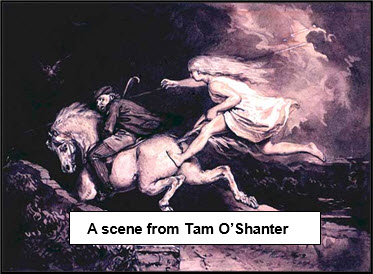 xxxxxBut whilst many of his poems have stood the test of time, it is probably as a song and ballad writer that Burns is best remembered today. His love songs are some of the finest ever produced. After his volume of poetic works had brought him fame and a modicum of fortune -
xxxxxBut whilst many of his poems have stood the test of time, it is probably as a song and ballad writer that Burns is best remembered today. His love songs are some of the finest ever produced. After his volume of poetic works had brought him fame and a modicum of fortune -
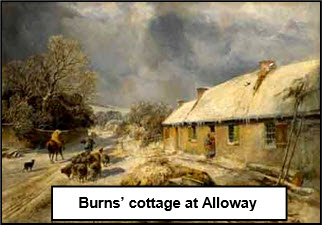
xxxxxBurns was born in Alloway, near Ayr, the son of a struggling tenant farmer. He attended the village school, but by the age of 13 he was out helping his father in the fields. Following his father’s death in 1784, he and his brother Gilbert became joint tenants of Mossgiel Farm near Mauchline, but the venture proved a failure. It was at this time that, faced with a disastrous love affair, he thought of emigrating to Jamaica. It was in order to raise the money for his passage, that he decided to publish his collection of poems, composed over a number of years and based on his own reading, and on folk songs and legends told to him by his parents. Produced locally at Kilmarnock in 1786 under the title Poems, Chiefly in the Scottish Dialect -
xxxxxSo with the money gained by the publication of his poems he turned again to farming, buying Ellisland on the banks of the Nith, near Dumfries. But this was also a failure and in 1789, after his marriage to ”Bonnie Jean” Armour, he was appointed an excise officer and moved to Dumfries two years later. The following year his outspoken support of the French Revolution almost cost him his job, but he managed to survive. It was from this time onwards that he devoted his energies to his songs and ballads. He contributed some 200 to Scots Musical Museum, and later, in 1793, compiled about 100 songs for the Select Collection of Original Scottish Airs.
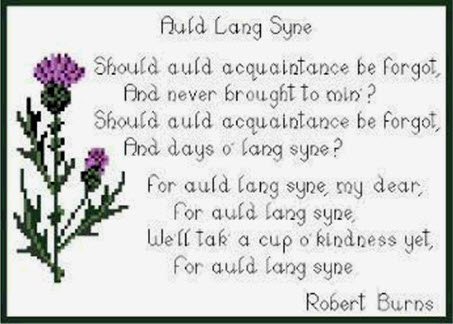 xxxxxBurns died at Dumfries in 1796 and was buried there. He was only 37. He had led a stormy romantic life -
xxxxxBurns died at Dumfries in 1796 and was buried there. He was only 37. He had led a stormy romantic life -
xxxxxIncidentally, we certainly owe the song Auld Lang Syne to Burns, though he may possibly have been inspired by an earlier poem entitled Old Long Syne, a work ascribed to the 17th century Scottish poet Sir Robert Ayton (1570-
xxxxx….. Following the enormous success of his work Poems, Chiefly in the Scottish Dialect, published in 1786, the first volume was expanded by two further editions in 1787 and 1793. Two short extracts from these poems must suffice:
As fair art thou, my bonnie lass
So deep in love am I;
And I will love thee still, my dear,
Till a’ the seas gang dry.
From My Love is like a Red, Red Rose
But mousie, thou art no thy lane
In proving foresight may be vain
The best-
Gang aft agley,
An’ leave us nought but grief and pain
For promised joy.
From To a Mouse
Acknowledgements
Burns: by the Scottish portrait painter Alexander Nasmyth (1758-
Including:
William Cowper

xxxxxThe English poet William Cowper (1731-
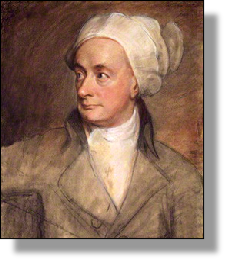 xxxxxAnother poet of this period who, like Burns, delighted in the simple sights and pleasures of country life, was the Englishman William Cowper. Born in Great Berkhampsted in Hertfordshire in 1731, the son of an Anglican clergyman, his mother died when he was six, and he was sent away to a boarding school and then Westminster School in London. From then on his health deteriorated. He began to suffer from severe fits of depression in his twenties and later, in 1763, was obliged to spend eighteen months in an asylum. This put an end to his hopes of becoming a lawyer, and he sought comfort in religion. It was at this time that he was befriended by the Reverend Morley Unwin and his wife Mary, devout Calvinists living in Huntingdon, Cambridgeshire. On leaving the asylum he went to live with them for two weeks, and ended up staying with the family for twenty-
xxxxxAnother poet of this period who, like Burns, delighted in the simple sights and pleasures of country life, was the Englishman William Cowper. Born in Great Berkhampsted in Hertfordshire in 1731, the son of an Anglican clergyman, his mother died when he was six, and he was sent away to a boarding school and then Westminster School in London. From then on his health deteriorated. He began to suffer from severe fits of depression in his twenties and later, in 1763, was obliged to spend eighteen months in an asylum. This put an end to his hopes of becoming a lawyer, and he sought comfort in religion. It was at this time that he was befriended by the Reverend Morley Unwin and his wife Mary, devout Calvinists living in Huntingdon, Cambridgeshire. On leaving the asylum he went to live with them for two weeks, and ended up staying with the family for twenty-
xxxxxIn 1767 Morley Unwin was killed in a riding accident, and his family, together with Cowper, moved to Olney in Buckinghamshire. Herexhe struck up a close friendship with the curate of the village John Newton (1725-
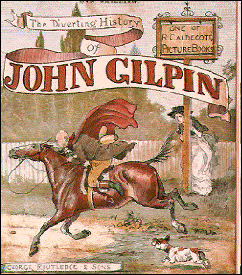
xxxxxAfter a further bout of depression, verging on madness, Cowper again turned to writing poetry, with many of his themes suggested by Mary Unwin. In 1782 he produced his Poems and these included Table Talk, The Progress of Error, and Truth, composed for the most part in a cheerful vein. Then followed the work by which he is best remembered today, his popular The Diverting History of John Gilpin, a ballad which told the amusing tale of a shopkeeper and his wife whose plans for their wedding anniversary go seriously awry. In 1785 he produced The Task, the work which brought him unexpected fame, and confirmed his reputation as an outstanding poet. A poem in blank verse and stretching over six books, it describes nature and rural life in comparatively simple terms, revealing his deep love of nature and the countryside, his understanding of the joys and tribulations within a farming community, and his deep concern for the poor and the suffering.
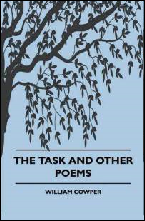 xxxxxFollowing the success of The Task, Cowper moved to the neighbouring village of Weston and began translating Homer, but it all proved too much for him. He gave up this work, and in 1795 he moved with Mary Unwin to Norfolk, settling at East Dereham. By this time, however, Mary was seriously ill and when she died in December the following year he went into a state of deep despair from which he never recovered. To this period belongs his The Castaway. Written in 1799, this sad work tells of the religious doubts and fears of damnation which had tormented him throughout his life. He died the following year.
xxxxxFollowing the success of The Task, Cowper moved to the neighbouring village of Weston and began translating Homer, but it all proved too much for him. He gave up this work, and in 1795 he moved with Mary Unwin to Norfolk, settling at East Dereham. By this time, however, Mary was seriously ill and when she died in December the following year he went into a state of deep despair from which he never recovered. To this period belongs his The Castaway. Written in 1799, this sad work tells of the religious doubts and fears of damnation which had tormented him throughout his life. He died the following year.
xxxxxCowper’s poetic work The Task, together with a number of his earlier poems (such as The Poplar Trees) take up the love-
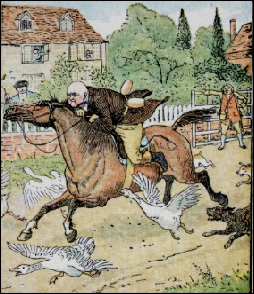
xxxxxIncidentally, the story of The Diverting History of John Gilpin, was suggested to Cowper by a neighbour, Lady Austen. He wrote it to prove to his critics that he had a sense of humour, and it became extremely popular throughout London when published in 1783. It is said that one printer alone sold 6,000 copies of the ballad. It tells of a London linen-
G3b-


